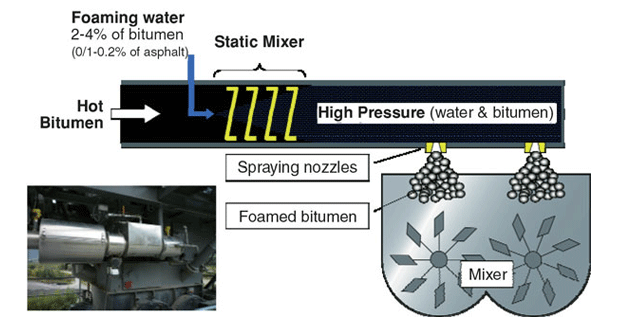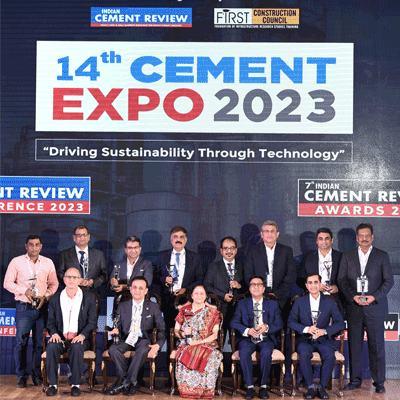- Home
- Technology
- From Foam to Form

From Foam to Form
Reducing the carbon footprint, saving energy and protecting the environment are all becoming increasingly important in road construction in India.
In the entire road construction process, the hot asphalt mixing plant probably emits the highest amount of CO2, consumes the most fuel and generates maximum pollution. In fact, a good asphalt mixing plant emits about 50 kg of CO2 per tonne of asphalt mix produced.
In line with the Ammann Group´s focus on ecology, our global R&D team constantly strives to improve the efficiency of processes in asphalt plants. Successful development of foam asphalt technology has been a major step to achieve significant reduction in carbon footprint, save fuel and costs as well as reduce emissions, and have a cleaner environment on the paving site. In fact, the Ammann foam asphalt system has been successfully tried and tested in many countries by building roads and monitoring wear performance for over a decade now. Thus, the system is refined and well-established to deliver consistent performance.
Producing warm asphalt
There are many methods to produce warm asphalt by adding wax, sulphur-based additives, etc. But in such methods, the additives have an adverse effect on the plant and the environment, not to mention incurring additional cost.
For example, sulphur-based additives cause high corrosion of ducts and bag filters owing to high SO2 content in exhaust gases and pose an environmental hazard on the paving site because of the emission of sulphur fumes. As against these techniques, Ammann foam uses just a small amount of normal water, the cost of which is negligible, which does not have any adverse effect on the plant or on the paving site environment.
The key objectives of any warm asphalt technique are:
- Same quality of paving and compaction and same equipment for paving and compaction.
- Lowest possible temperature of hot asphalt mix.
- Maximum time window for paving and compaction to allow for transportation time for hot mix from plant to the paving site.
The Ammann foam asphalt technique achieves all these key objectives.
The process
The fundamental principle of proper coating of bitumen and proper properties of asphalt mix for required paving compaction is to have the right viscosity of bitumen. The conventional belief is that we need the right temperature of bitumen for proper coating but the fundamental factor is that we need the right viscosity of the bitumen; because we get the right viscosity at about 150 or 1,600 C, we need to heat the bitumen to this temperature. Otherwise, for drying the aggregate, we only need to heat above the vaporisation temperature of water and not up to 1,600 C. So, if we develop a method by which we get the required viscosity of bitumen at a lower temperature, it will render the right properties of hot mix for required paving and compaction performance.
In the Ammann foaming technique, the right viscosity of bitumen is achieved by adding a very small quantity of water (about 2-4 per cent of bitumen) at the right pressure and in the right quantity at the right temperature and pressure of bitumen to create a foam, which immediately reduces the viscosity of the bitumen ensuring proper coating in the mixer.
The bitumen is to be heated to the usual temperature of around 1,500 C. A bitumen pump mounted on the mixing section pumps the hot bitumen from the weighing scale through the foaming circuit at the right pressure; the water pump, pumps the water from a small tank on the mixing section in the precisely required flow rate and at the right pressure, which is injected through a special nozzle in the path of pressurised hot bitumen in an enclosed pipeline. This mixture of water and bitumen is then passed through a static mixer, which distributes the water in the bitumen to ensure a uniform and thorough foam. Then, this pressurised mixture of bitumen and water is injected through special nozzles into the pug mill.
As the drop in viscosity is sharp, the coating effectiveness is extremely good. As seen from the comparison of change in viscosity with time and temperature between normal hot bitumen, bitumen with wax addition and foam bitumen, we can see how sharply the viscosity drops even below the normal hot bitumen during mixing phase in case of foam bitumen, and then increases slowly to reach closer to that of the normal hot bitumen, giving a very wide time window for paving and compaction.
On the other hand, in case of wax additive method of warm asphalt, viscosity changes are in shorter duration, providing a small time window within which proper paving and compaction performance can be achieved. Proper and thorough foam generation on a consistent basis is extremely important to gain confidence that the warm mix produced by the plant has consistent paving and compaction performance. And for this, the system has to be well researched, all the important process parameters understood and established and proper sensing and controls logic established to constantly monitor and correct the process to ensure consistent performance of the mix and, thus, consistent quality of road. Simply injecting the water and generating foam does not ensure consistent quality of foam batch-after-batch, day-after-day without much intelligence required on the part of the plant operator. The Ammann foam system has evolved through years of research, field tests in different countries under different climatic conditions and with different grades of bitumen; all the parameters are derived and incorporated into the control logic to ensure consistent quality of warm asphalt. The process ensures sufficiently large expansion rates of around 10 times and sufficiently longer half life time of around 5 seconds.
Environmental effects
Besides the major advantage of saving fuel and costs as well as precious natural resources, the warm asphalt mix generates very low fumes on the mixing plant as well as the paving site, making the work much more environment-friendly and safer for the people working on site.
In conclusion
Indeed, foam asphalt has many advantages and meets all the key objectives of saving fuel cost, protecting the environment and rendering optimal paving and compaction performance, thus not compromising on the quality and life of the road.
About the Author:
Dharmesh Mashru,
CEO-Asphalt Plants Business, Ammann Apollo India Pvt Ltd, is an engineer with 32 years of experience in the engineering industry and an expert in asphalt plants technology.
During road construction, the Ammann Group´s foam asphalt technology can reduce both carbon footprint and costs, as DHARMESH MASHRU explains. Reducing the carbon footprint, saving energy and protecting the environment are all becoming increasingly important in road construction in India. In the entire road construction process, the hot asphalt mixing plant probably emits the highest amount of CO2, consumes the most fuel and generates maximum pollution. In fact, a good asphalt mixing plant emits about 50 kg of CO2 per tonne of asphalt mix produced. In line with the Ammann Group´s focus on ecology, our global R&D team constantly strives to improve the efficiency of processes in asphalt plants. Successful development of foam asphalt technology has been a major step to achieve significant reduction in carbon footprint, save fuel and costs as well as reduce emissions, and have a cleaner environment on the paving site. In fact, the Ammann foam asphalt system has been successfully tried and tested in many countries by building roads and monitoring wear performance for over a decade now. Thus, the system is refined and well-established to deliver consistent performance. Producing warm asphalt There are many methods to produce warm asphalt by adding wax, sulphur-based additives, etc. But in such methods, the additives have an adverse effect on the plant and the environment, not to mention incurring additional cost. For example, sulphur-based additives cause high corrosion of ducts and bag filters owing to high SO2 content in exhaust gases and pose an environmental hazard on the paving site because of the emission of sulphur fumes. As against these techniques, Ammann foam uses just a small amount of normal water, the cost of which is negligible, which does not have any adverse effect on the plant or on the paving site environment. The key objectives of any warm asphalt technique are: Same quality of paving and compaction and same equipment for paving and compaction. Lowest possible temperature of hot asphalt mix. Maximum time window for paving and compaction to allow for transportation time for hot mix from plant to the paving site. The Ammann foam asphalt technique achieves all these key objectives. The process The fundamental principle of proper coating of bitumen and proper properties of asphalt mix for required paving compaction is to have the right viscosity of bitumen. The conventional belief is that we need the right temperature of bitumen for proper coating but the fundamental factor is that we need the right viscosity of the bitumen; because we get the right viscosity at about 150 or 1,600 C, we need to heat the bitumen to this temperature. Otherwise, for drying the aggregate, we only need to heat above the vaporisation temperature of water and not up to 1,600 C. So, if we develop a method by which we get the required viscosity of bitumen at a lower temperature, it will render the right properties of hot mix for required paving and compaction performance. In the Ammann foaming technique, the right viscosity of bitumen is achieved by adding a very small quantity of water (about 2-4 per cent of bitumen) at the right pressure and in the right quantity at the right temperature and pressure of bitumen to create a foam, which immediately reduces the viscosity of the bitumen ensuring proper coating in the mixer. The bitumen is to be heated to the usual temperature of around 1,500 C. A bitumen pump mounted on the mixing section pumps the hot bitumen from the weighing scale through the foaming circuit at the right pressure; the water pump, pumps the water from a small tank on the mixing section in the precisely required flow rate and at the right pressure, which is injected through a special nozzle in the path of pressurised hot bitumen in an enclosed pipeline. This mixture of water and bitumen is then passed through a static mixer, which distributes the water in the bitumen to ensure a uniform and thorough foam. Then, this pressurised mixture of bitumen and water is injected through special nozzles into the pug mill. As the drop in viscosity is sharp, the coating effectiveness is extremely good. As seen from the comparison of change in viscosity with time and temperature between normal hot bitumen, bitumen with wax addition and foam bitumen, we can see how sharply the viscosity drops even below the normal hot bitumen during mixing phase in case of foam bitumen, and then increases slowly to reach closer to that of the normal hot bitumen, giving a very wide time window for paving and compaction. On the other hand, in case of wax additive method of warm asphalt, viscosity changes are in shorter duration, providing a small time window within which proper paving and compaction performance can be achieved. Proper and thorough foam generation on a consistent basis is extremely important to gain confidence that the warm mix produced by the plant has consistent paving and compaction performance. And for this, the system has to be well researched, all the important process parameters understood and established and proper sensing and controls logic established to constantly monitor and correct the process to ensure consistent performance of the mix and, thus, consistent quality of road. Simply injecting the water and generating foam does not ensure consistent quality of foam batch-after-batch, day-after-day without much intelligence required on the part of the plant operator. The Ammann foam system has evolved through years of research, field tests in different countries under different climatic conditions and with different grades of bitumen; all the parameters are derived and incorporated into the control logic to ensure consistent quality of warm asphalt. The process ensures sufficiently large expansion rates of around 10 times and sufficiently longer half life time of around 5 seconds. Environmental effects Besides the major advantage of saving fuel and costs as well as precious natural resources, the warm asphalt mix generates very low fumes on the mixing plant as well as the paving site, making the work much more environment-friendly and safer for the people working on site. In conclusion Indeed, foam asphalt has many advantages and meets all the key objectives of saving fuel cost, protecting the environment and rendering optimal paving and compaction performance, thus not compromising on the quality and life of the road. About the Author: Dharmesh Mashru, CEO-Asphalt Plants Business, Ammann Apollo India Pvt Ltd, is an engineer with 32 years of experience in the engineering industry and an expert in asphalt plants technology.
























